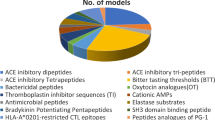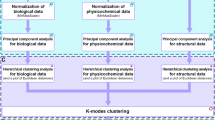Abstract
In this paper, we present a pipeline to perform improved QSAR analysis of peptides. The modeling involves a double selection procedure that first performs feature selection and then conducts sample selection before the final regression analysis. Five hundred and thirty-one physicochemical property parameters of amino acids were used as descriptors to characterize the structure of peptides. These high-dimensional descriptors then go through a feature selection process given by the binary matrix shuffling filter (BMSF) to obtain a set of important low-dimensional features. Each descriptor that passes the BMSF filtering also receives a weight defined through its contribution to reduce the estimation error. These selected features served as the predictors for subsequent sample selection and modeling. Based on the weighted Euclidean distances between samples, a common range was determined with high-dimensional semivariogram and then used as a threshold to select the near-neighbor samples from the training set. For each sample to be predicted, the QSAR model was established using SVR with the weighted, selected features based on the exclusive set of near-neighbor training samples. Prediction was conducted for each test sample accordingly. The performances of this pipeline are tested with the QSAR analysis of angiotensin-converting enzyme inhibitors and HLA-A*0201 data sets. Improved prediction accuracy was obtained in both applications. This pipeline can optimize the QSAR modeling from both the feature selection and sample selection perspectives. This leads to improved accuracy over single selection methods. We expect this pipeline to have extensive application prospect in the field of regression prediction.


Similar content being viewed by others
References
Chang CC, Lin CJ (2011) LIBSVM: a library for support vector machines. ACM T Intelli Syst Techn (TIST) 2:27
Collantes ER, Dunn WJ (1995) Amino acid side chain descriptors for quantitative structure–activity relationship studies of peptide analogues. J Med Chem 38:2705–2713
Doytchinova IA, Walshe V, Borrow P et al (2005) Towards the chemometric dissection of peptide–HLA-A* 0201 binding affinity: comparison of local and global QSAR models. J Comput Aided Mol Des 19:203–212
Eriksson L, Johansson E, Müller M et al (2000) On the selection of the training set in environmental QSAR analysis when compounds are clustered. J Chemom 14:599–616
Furusjö E, Svenson A, Rahmberg M et al (2006) The importance of outlier detection and training set selection for reliable environmental QSAR predictions. Chemosphere 63:99–108
Gedeck P, Rohde B, Bartels C (2006) QSAR-how good is it in practice? Comparison of descriptor sets on an unbiased cross section of corporate data sets. J Chem Inf Model 46:1924–1936
Golbraikh A, Tropsha A (2002) Beware of q 2! J Mol Graphics Model 20:269–276
Hellberg S, Eriksson L, Jonsson J et al (1991) Minimum analogue peptide sets (MAPS) for quantitative structure–activity relationships. Int J Pept Protein Res 37:414–424
Hemmateenejad B, Yousefinejad S, Mehdipour AR (2011) Novel amino acids indices based on quantum topological molecular similarity and their application to QSAR study of peptides. Amino Acids 40:1169–1183
Hemmateenejad B, Miri R, Elyasi M (2012) A segmented principal component analysis-regression approach to QSAR study of peptides. J Theor Biol 305:37–44
Hou T, McLaughlin W, Lu B et al (2006) Prediction of binding affinities between the human amphiphysin-1 SH3 domain and its peptide ligands using homology modeling, molecular dynamics and molecular field analysis. J Proteome Res 5:32–43
Hou T, Zhang W, Case DA et al (2008) Characterization of domain–peptide interaction interface: a case study on the amphiphysin-1 SH3 domain. J Mol Bio 376:1201–1214
Hou T, Xu Z, Zhang W et al (2009) Characterization of domain–peptide interaction interface A generic structure-based model to decipher the binding specificity of SH3 domains. Mol Cell Proteomics 8:639–649
Hou T, Li N, Li Y et al (2012) Characterization of domain–peptide interaction interface: prediction of SH3 domain-mediated protein–protein interaction network in yeast by generic structure-based models. J Proteome Res 11:2982–2995
Journel AG, Huijbregts CJ (1978) Mining geostatistics. Academic press, London
Kawashima S, Kanehisa M (2000) AAindex: amino acid index database. Nucleic Acids Res 28:374
Kidera A, Konishi Y, Oka M et al (1985) Statistical analysis of the physical properties of the 20 naturally occurring amino acids. J Protein Chem 4:23–55
Leardi R (2000) Application of genetic algorithm-PLS for feature selection in spectral data sets. J Chemom 14:643–655
Li J, Gao XB, Jiao LC (2005) A new feature weighted fuzzy clustering algorithm. In: Rough sets, fuzzy sets, data mining, and granular computing. Springer Berlin, Heidelberg, pp 412–420
Liang GZ, Zhou P, Zhou Y et al (2006) New descriptors of amino acids and their applications to peptide quantitative structure–activity relationship. Acta Chim Sin 64:393–396
Liang G, Yang L, Kang L et al (2009) Using multidimensional patterns of amino acid attributes for QSAR analysis of peptides. Amino Acid 37:583–591
Lin ZH, Long HX, Bo Z et al (2008) New descriptors of amino acids and their application to peptide QSAR study. Peptides 29:1798–1805
Sandberg M, Eriksson L, Jonsson J et al (1998) New chemical descriptors relevant for the design of biologically active peptides. A multivariate characterization of 87 amino acids. J Med Chem 41:2481–2491
Sewald N, Jakubke HD (2002) Peptides: chemistry and biology (vol. 2). Wiley-Vch, Weinheim
Sheridan RP, Feuston BP, Maiorov VN et al (2004) Similarity to molecules in the training set is a good discriminator for prediction accuracy in QSAR. J Chem Inf Model 44:1912–1928
Tian F, Zhou P, Li Z (2007) T-scale as a novel vector of topological descriptors for amino acids and its application in QSARs of peptides. J Mol Struct 830:106–115
Tomii K, Kanehisa M (1996) Analysis of amino acid indices and mutation matrices for sequence comparison and structure prediction of proteins. Protein Eng 9:27–36
Tropsha A, Gramatica P, Gombar VK (2003) The importance of being earnest: validation is the absolute essential for successful application and interpretation of QSPR models. QSAR Comb Sci 22:69–77
Vivencio DP, Hruschka ER, Nicoletti MC et al (2007) Feature-weighted k-nearest neighbor classifier. In: Foundations of computational intelligence, 2007. FOCI 2007. IEEE Symposium on (pp 481–486). IEEE
Wölfel M, Ekenel HK (2005) Feature weighted Mahalanobis distance: improved robustness for Gaussian classifiers. In: 13th European signal processing conference
Xu Z, Hou T, Li N et al (2012) Proteome-wide detection of Abl1 SH3-binding peptides by integrating computational prediction and peptide microarray. Mol Cell Proteomics 11(O111):010389
Yousefinejad S, Hemmateenejad B, Mhedipour AR (2012) New autocorrelation QTMS-based descriptors for use in QSAM of peptides. J Iran Chem Soc 9:569–577
Zhang H, Wang H, Dai Z et al (2012) Improving accuracy for cancer classification with a new algorithm for genes selection. BMC Bioinformatics 13:1–20
Zhou P, Chen X, Wu YQ et al (2010) Gaussian process: an alternative approach for QSAM modeling of peptides. Amino Acid 38:199–212
Acknowledgments
This work was supported by the Doctoral Foundation of Ministry of Education of China (No. 20124320110002), the Scientific Research Fund of the Hunan Provincial Financial Department (No. 62020411074) and the Postgraduate Scientific Research Innovation Project of Hunan Province, China (No. CX2013B306). The work of H. Wang was partially supported by a grant from the Simons Foundation (#246077).
Conflict of interest
The authors declare no conflict of interest.
Author information
Authors and Affiliations
Corresponding author
Additional information
Z. Dai and L. Wang authors contributed equally to this work.
Electronic supplementary material
Below is the link to the electronic supplementary material.
Rights and permissions
About this article
Cite this article
Dai, Z., Wang, L., Chen, Y. et al. A pipeline for improved QSAR analysis of peptides: physiochemical property parameter selection via BMSF, near-neighbor sample selection via semivariogram, and weighted SVR regression and prediction. Amino Acids 46, 1105–1119 (2014). https://doi.org/10.1007/s00726-014-1667-5
Received:
Accepted:
Published:
Issue Date:
DOI: https://doi.org/10.1007/s00726-014-1667-5




